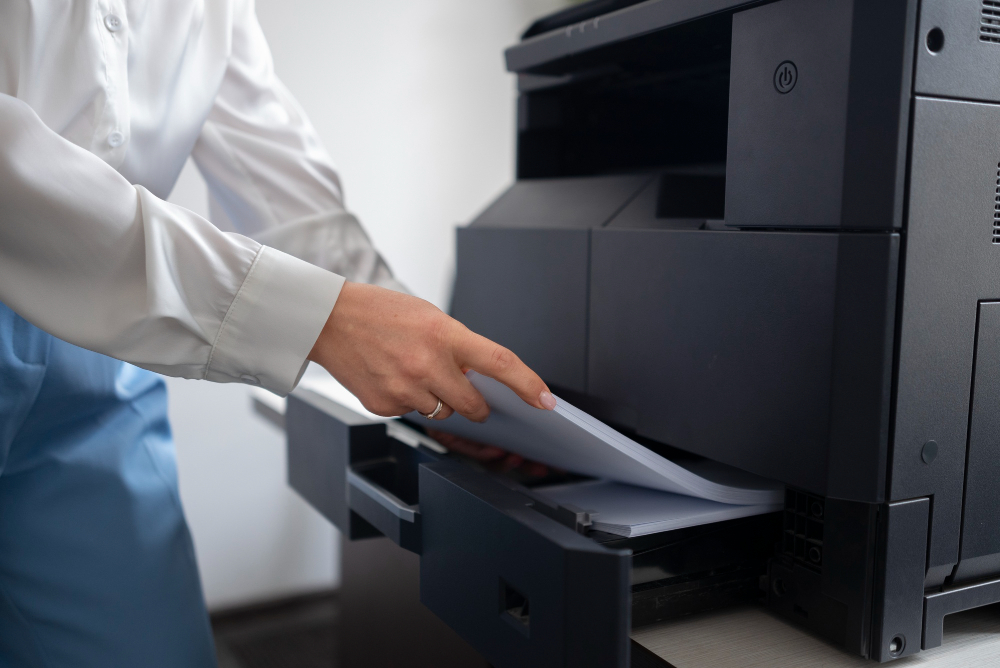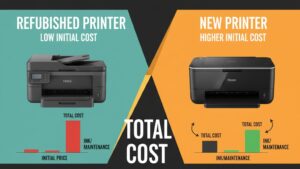Introduction
Common printer glitches affect millions of users daily, turning simple printing tasks into frustrating technical challenges that disrupt productivity and workflow. Whether you’re trying to print an important document for a meeting or helping your kids with homework, printer malfunctions always seem to occur at the worst possible moments.
Research indicates that the average office worker loses approximately 21 minutes per week dealing with printer issues, while home users report printer problems as one of their top technology frustrations. The complexity of modern printing technology, combined with various connectivity options and software integration, creates multiple potential failure points.
However, most printer glitches follow predictable patterns with established solutions that don’t require technical expertise or expensive service calls. Understanding these common issues and their fixes empowers users to resolve problems quickly and maintain reliable printing performance.
This comprehensive guide examines the most frequent printer malfunctions encountered across different printer types and brands, providing step-by-step solutions that work for both novice and experienced users seeking to restore their printing capabilities efficiently.
What Are Printer Glitches?
Printer glitches are temporary or persistent malfunctions that prevent printers from operating correctly or producing expected output quality. These issues range from simple software conflicts and connectivity problems to mechanical failures and consumable-related errors that affect printing performance.
Unlike permanent hardware failures that require replacement parts or professional repair, glitches typically result from configuration problems, driver conflicts, temporary system errors, or maintenance-related issues that users can resolve through systematic troubleshooting approaches.
Modern printers combine mechanical, electronic, and software components that must work together seamlessly. When any component experiences problems, it can manifest as various symptoms including failed print jobs, poor output quality, error messages, or complete system unresponsiveness.
Glitches often occur after system updates, driver changes, network modifications, or extended periods of inactivity. Environmental factors like dust accumulation, temperature changes, and humidity fluctuations can also trigger seemingly random printer malfunctions that appear without obvious causes.
The key distinction between glitches and serious hardware problems is that glitches can usually be resolved through software adjustments, basic maintenance, or configuration changes rather than requiring component replacement or professional intervention.
7 Most Frequent Printer Glitches and Their Solutions

Glitch 1: Printer Not Responding or Appearing Offline
This frustrating issue occurs when your computer cannot communicate with the printer despite apparent physical connections. The printer may show as “offline” in your computer’s device list even when powered on and ready.
Start by checking all physical connections, ensuring USB cables are securely attached or wireless connections are active. Restart both your computer and printer to reset communication protocols and clear temporary connection errors.
Update or reinstall printer drivers from the manufacturer’s official website, as outdated drivers frequently cause communication failures. Remove the printer from your computer’s device list and reinstall it to establish fresh connection protocols.
Glitch 2: Paper Jams That Keep Recurring
Persistent paper jams indicate underlying mechanical issues or improper paper handling rather than random occurrences. These glitches waste time and can damage internal printer components if handled incorrectly.
Always turn off the printer before clearing jams to prevent injury and mechanical damage. Open all accessible panels and carefully remove visible paper pieces, pulling in the direction of normal paper travel to avoid tearing.
Check paper loading procedures, ensuring sheets are properly aligned and not exceeding tray capacity limits. Examine paper quality and type compatibility, as using incorrect media specifications causes frequent feeding problems.

Glitch 3: Print Quality Issues and Streaking
Poor print quality manifests as streaking, fading, color inconsistencies, or missing elements that make documents unreadable or unprofessional. These printer glitch solutions often involve maintenance rather than replacement.
Run your printer’s built-in cleaning cycles to clear clogged print heads and restore proper ink flow. Perform this process 2-3 times for stubborn clogs, allowing drying time between cycles.
Check ink or toner levels and replace low cartridges even if they show remaining capacity. Inconsistent supply levels cause quality variations that cleaning alone cannot resolve.
Glitch 4: Extremely Slow Printing Speeds
When printers suddenly become much slower than normal, software settings or network issues are usually responsible rather than hardware degradation. This glitch particularly affects productivity in busy environments.
Check print quality settings, as “high quality” or “photo” modes significantly slow printing speeds. Adjust to “draft” or “normal” quality for everyday documents that don’t require premium output.
For network printers, verify connection strength and consider switching to wired connections if wireless performance is inconsistent. Close unnecessary programs that might compete for system resources during printing.

Glitch 5: Blank Pages or Partial Printing
Documents that print with missing content, blank pages, or cut-off text indicate software conflicts or incorrect page setup rather than hardware failures. These issues often appear suddenly after software updates.
Verify page setup settings in your document software, checking margins, page orientation, and scaling options. Ensure document content fits within printable areas defined by your printer’s specifications.
Update or reinstall printer drivers and check for software conflicts with recently installed programs. Some applications interfere with print job processing, causing incomplete output.
Glitch 6: Error Messages and Blinking Lights
Cryptic error codes and flashing indicator lights communicate specific problems but often confuse users who don’t understand their meaning. These visual cues provide valuable diagnostic information when properly interpreted.
Consult your printer manual or manufacturer’s website to decode specific error messages and light patterns. Each combination typically indicates particular problems with established solution procedures.
Document recurring error patterns to identify underlying causes rather than repeatedly applying temporary fixes. Persistent errors often indicate maintenance needs or configuration problems requiring systematic attention.
Glitch 7: WiFi Connectivity Drops and Network Issues
Wireless printers frequently lose network connections, especially after router updates or network changes. These connectivity glitches disrupt printing workflows and require systematic network troubleshooting.
Check that your printer and router are within acceptable range limits and that no physical obstructions interfere with wireless signals. Move the printer closer to your router if signal strength appears weak.
Update printer firmware and wireless drivers to ensure compatibility with current network protocols. Reset network settings on your printer and reconfigure WiFi connections using current passwords and security settings.

Advanced Diagnostic Tools for Printer Malfunction Fixes
Beyond basic troubleshooting, specialized software tools can diagnose complex printer problems more efficiently than manual testing. Most major printer manufacturers provide free diagnostic utilities like HP Print and Scan Doctor or Canon My Printer that automatically detect and resolve common issues.
These tools perform comprehensive system scans, checking driver integrity, connection status, and hardware functionality simultaneously. They often fix problems automatically or provide specific guidance for manual resolution steps.
Network diagnostic tools become essential for wireless printer troubleshooting, helping identify interference sources, signal strength problems, and configuration conflicts that cause connectivity issues.
Third-party utilities like DriverEasy or Driver Booster can maintain updated drivers across multiple devices, preventing compatibility-related glitches. However, always download drivers from official manufacturer sources to ensure authenticity and security.
Common Troubleshooting Mistakes That Worsen Glitches
Many users inadvertently complicate printer problems by applying inappropriate solutions or skipping systematic diagnostic steps. Forcing mechanical components during paper jam removal often causes more damage than the original problem, requiring expensive repairs.
Randomly changing software settings without understanding their effects frequently creates new problems while leaving original issues unresolved. Always document current settings before making changes, enabling easy restoration if modifications cause additional complications.
Ignoring maintenance schedules leads to preventable glitches that could be avoided through regular cleaning and consumable replacement. Inkjet printers particularly require consistent use and maintenance to prevent print head clogging and mechanical problems.
Using incompatible or counterfeit consumables creates various quality and reliability issues that appear to be printer malfunctions. Stick to manufacturer-recommended papers, inks, and toners to maintain optimal performance and avoid warranty complications.
Another frequent mistake involves attempting multiple solutions simultaneously, making it impossible to identify which approach actually resolved the problem. Apply one fix at a time and test results thoroughly before trying additional measures.
Rushing through diagnostic procedures often leads to overlooking simple solutions in favor of complex repairs. Always start with basic checks like power connections and supply levels before progressing to advanced troubleshooting steps.
Frequently Asked Questions
Why do printer glitches seem to happen at the worst times? Printer problems often surface during heavy use periods when mechanical components are stressed and software conflicts become apparent. Regular maintenance and proactive troubleshooting help prevent crisis situations.
How can I prevent most common printer glitches from occurring? Establish monthly maintenance routines including print head cleaning, driver updates, and supply level monitoring. Use quality consumables and keep printers in clean, stable environments away from extreme temperatures.
Should I try to fix printer glitches myself or call for professional help? Most common glitches can be resolved using manufacturer-provided troubleshooting guides and diagnostic tools. Consider professional service only for persistent hardware problems or issues requiring component replacement.
What’s the difference between a glitch and a serious printer problem? Glitches are typically temporary issues caused by software conflicts, connectivity problems, or minor maintenance needs. Serious problems involve hardware component failures requiring replacement parts or professional repair services.
Conclusion
Understanding common printer glitches and their proven solutions transforms frustrating technical problems into manageable maintenance tasks that most users can handle independently. The systematic approach outlined in this guide addresses the majority of printer issues encountered in both home and office environments.
Remember that prevention through regular maintenance often proves more effective than reactive troubleshooting. Establishing consistent cleaning schedules, monitoring consumable levels, and keeping software updated significantly reduces the frequency and severity of printer glitches.
The key to successful glitch resolution lies in systematic problem-solving rather than random attempts at fixes. Start with simple solutions, apply one change at a time, and document what works for future reference when similar issues arise.
By developing these troubleshooting skills and understanding common glitch patterns, you’ll maintain reliable printing performance while avoiding the time, cost, and frustration associated with frequent printer problems. Keep this guide accessible for quick reference during future printing challenges.
Printer Troubleshooting Guide: Easy Fixes for Beginners Read More.





Recent Comments